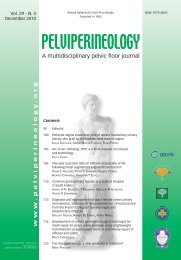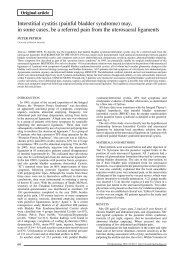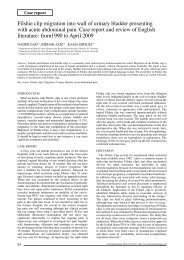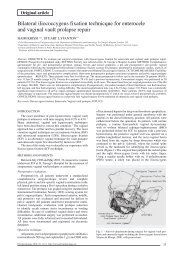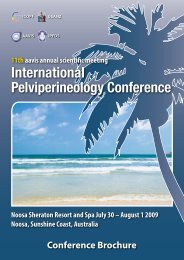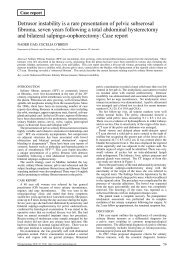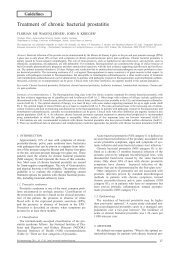This Issue Complete PDF - Pelviperineology
This Issue Complete PDF - Pelviperineology
This Issue Complete PDF - Pelviperineology
You also want an ePaper? Increase the reach of your titles
YUMPU automatically turns print PDFs into web optimized ePapers that Google loves.
V. Kalis - J. Stepan Jr. - Z. Novotny - P. Chaloupka - M. Kralickova - Z. Rokyta<br />
11. Banninger U, Buhrig H, Schreiner WE. A comparison between<br />
chromic catgut and polyglycolic acid sutures in episiotomy<br />
repair. Geburtshilfe Frauenheilkd 1978; 38: 30-33.<br />
12. Mahomed K, Grant A, Ashurst H, James D. The Southmead<br />
perineal suture study. A randomized comparison of suture<br />
materials and suturing techniques for repair of perineal trauma.<br />
Br J Obstet Gynaecol. 1989; 96: 1272-1280.<br />
13. Dencker A, Lundgren I, Sporrong T. Suturing after childbirth<br />
– a randomised controlled study testing a new monofilament<br />
material. BJOG 2006; 113: 114-116.<br />
14. Morano S, Mistrangelo E, Pastorino D, et al. A randomized<br />
comparison of suturing techniques for episiotomy and laceration<br />
repair after spontaneous vaginal birth. J Minim Invasive<br />
Gynecol. 2006; 13: 457-462.<br />
15. Gemynthe A, Langhoff-Roos J, Sahl S, Knudsen J. New<br />
VICRYL formulation: an improved Metod of perineal repair?<br />
Br J Midwifery 1996; 4: 230-234.<br />
16. McElhinney BR, Glenn DR, Dornan G, Harper MA. Episiotomy<br />
repair: Vicryl versus Vicryl rapide. Ulster Med J. 2000;<br />
69: 27-29.<br />
17. Kettle C, Hills RK, Jones P, et al. Continuous versus interrupted<br />
perineal repair with standard or rapidly absorbed sutures<br />
after spontaneous vaginal birth: a randomised controlled trial.<br />
Lancet. 2002; 359: 2217-2223.<br />
18. Fleming N. Can the suturing method make a difference in postpartum<br />
perineal pain? J Nurse Midwifery. 1990; 35: 19-25.<br />
19. http://www.ethicon.novartis.us<br />
20. DeLancey JOL, Hurd WW. Size of the urogenital hiatus in the<br />
levator ani muscles in normal women and women with pelvic<br />
organ prolapse. Obstet Gynecol. 1998; 91: 364-368.<br />
21. Sultan AH, Kamm MA, Hudson CN. Obstetric perineal trauma:<br />
an audit of training. J Obstet Gynaecol 1995; 15: 19-23.<br />
22. Kalis V, Stepan J. Jr., Horak M., Roztocil A., Kralickova M.,<br />
Rokyta Z. Definitions of Mediolateral Episiotomy in Europe.<br />
Int J Gynaecol Obstet 2008; 100: 188-189.<br />
23. RCOG Guideline No. 23. Methods and materials used in perineal<br />
repair. June 2004.<br />
24. http://www.aesculapusa.com<br />
25. Thakar R, Sultan AH. The Obstetrician and Gynaecologist.<br />
2003; 5: 31-39.<br />
Correspondence to:<br />
VLADIMIR KALIS<br />
Department of Obstetrics and Gynecology, University Hospital,<br />
Faculty of Medicine, Charles University<br />
Alej Svobody 80, 304 60 Plzen, Czech Republic<br />
Tel: +420 377 105 212 (work), +420 777 067 699 (mobile)<br />
Fax: +420 377 105 290<br />
E-mail: kalisv@fnplzen.cz<br />
Pelvic Floor Digest<br />
continued from page 11<br />
6 – INCONTINENCES<br />
The impact of fecal (FI) and urinary incontinence (UI) on quality of life 6 months after childbirth. Handa VL, Zyczynski HM, Burgio KL<br />
et al. Am J Obstet Gynecol. 2007;197:636. With validated questionnaires 759 primiparous women were assessed for FI and UI six months<br />
postpartum, measuring QOL with SF-12 summary scores, health utility index score (a measure of self-rated overall health), and the modified<br />
Manchester Health Questionnaire. Women with FI and those with UI had worse scores than women without incontinences or flatal incontinence<br />
only. FI and UI together have a greater impact than either condition alone.<br />
The impact of tension-free vaginal tape on overactive bladder symptoms in women with stress urinary incontinence: significance of<br />
detrusor overactivity. Choe JH, Choo MS, Lee KS. J Urol. 2007 Nov 12; epub. Evaluating the results of the TVT in 549 women (2003 to 2004)<br />
it is concluded that the tension-free vaginal tape procedure can be performed in women with stress urinary incontinence and overactive bladder<br />
including urge incontinence even if the patient has detrusor overactivity on urodynamic study. However, patients should be fully advised of the<br />
possibility of persistent overactive bladder symptoms and treatment for those symptoms after tension-free vaginal tape should be !" # o$ % &'<br />
Myoblast and fibroblast therapy for post-prostatectomy urinary incontinence: 1-year followup of 63 patients. Mitterberger M, Marksteiner<br />
R, Margreiter E et al. J Urol. 2007 Nov 12; epub. Transurethral ultrasound guided injections of autologous fibroblasts and myoblasts<br />
obtained from skeletal muscle biopsies were done in 63 patients with stress urinary incontinence after radical prostatectomy were treated with.<br />
One year after implantation 41 patients were continent, 17 showed improvement and 5 failed. Thickness and contractility of the rhabdosphincter<br />
were significantly improved postoperatively.<br />
Behavioral comorbidity differs in subtypes of enuresis and urinary incontinence. Zink S, Freitag CM, Gontard AV. J Urol. 2007 Nov 13;<br />
epub. Different subtypes of enuresis and urinary incontinence demonstrate differences in behavioral problems and psychiatric comorbidity.<br />
The highest rates of psychiatric comorbidity were found in the group of children with voiding postponement and the lowest were in children<br />
with monosymptomatic nocturnal enuresis. Screening for comorbid psychiatric disorders in children with enuresis and urinary incontinence is<br />
highly recommended, and further investigations in large groups of children are necessary.<br />
Evaluation and outcome measures in the treatment of female urinary stress incontinence: International Urogynecological Association<br />
(IUGA) guidelines for research and clinical practice. Ghoniem G, Stanford E, Kenton K et al. Int Urogynecol J Pelvic Floor Dysfunct.<br />
2008;19:5.<br />
The age distribution, rates, and types of surgery for stress urinary incontinence (SUI) in the USA. Shah AD, Kohli N, Rajan SS, Hoyte<br />
L. Int Urogynecol J Pelvic Floor Dysfunct. 2008;19:89. The distribution of SUI surgery across age groups in the USA in 2003 was studied:<br />
129,778 women underwent 165,776 surgical procedures. Of these women, 12.2, 53.0, 30.4, and 4.5% belonged to reproductive, perimenopausal,<br />
postmenopausal, and elderly age groups, respectively. Surgical rates (per 10,000 women) were 4, 17, 19, and 9 in these age groups,<br />
respectively. Complications occurred most frequently in reproductive age women. Women at all stages of reproductive life may seek surgical<br />
treatment for SUI, but the greatest percentage of surgical procedures occurred in perimenopausal women.<br />
Clinical and urodynamic outcomes of pubovaginal sling procedure with autologous rectus fascia for stress urinary incontinence. Mitsui<br />
T, Tanaka H, Moriya K et al. Int J Urol. 2007;14:1076. Pubovaginal sling surgery with autologous rectus fascia was done in 29 consecutive<br />
women with SUI. Overall SUI was cured in 23 patients and improved in 3 patients. Three patients who developed persistent urinary retention<br />
or severe voiding difficulty after surgery underwent urethrolysis. Of 17 patients who had urgency before the pubovaginal sling, urgency was<br />
cured postoperatively in seven, while de novo urgency appeared in one patient. Postvoid residual urine volume (PVR) >100 mL and Qmax<br />



